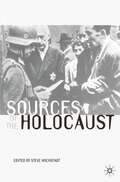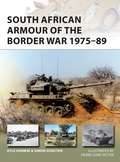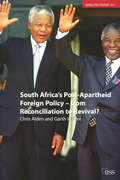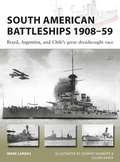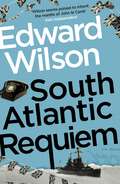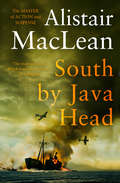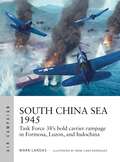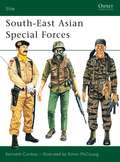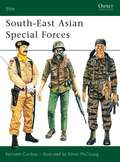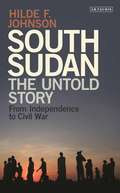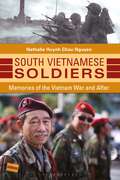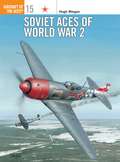- Table View
- List View
The Sources of Military Doctrine: France, Britain, and Germany Between the World Wars (Cornell Studies in Security Affairs)
by Barry R. PosenBarry R. Posen explores how military doctrine takes shape and the role it plays in grand strategy-that collection of military, economic, and political means and ends with which a state attempts to achieve security. Posen isolates three crucial elements of a given strategic doctrine: its offensive, defensive, or deterrent characteristics, its integration of military resources with political aims, and the degree of military or operational innovation it contains. He then examines these components of doctrine from the perspectives of organization theory and balance of power theory, taking into account the influence of technology and geography.Looking at interwar France, Britain, and Germany, Posen challenges each theory to explain the German Blitzkrieg, the British air defense system, and the French Army's defensive doctrine often associated with the Maginot Line. This rigorous comparative study, in which the balance of power theory emerges as the more useful, not only allows us to discover important implications for the study of national strategy today, but also serves to sharpen our understanding of the origins of World War II.
Sources of the Holocaust (Documents in History)
by Steve HochstadtThe Holocaust was the central event of the twentieth century. How can we understand the Nazi drive to murder millions of people, or the determination of concentration camp prisoners to survive? In this new collection of original documents and sources, Steve Hochstadt brings the reader into direct contact with the Holocaust's human participants. The words of Nazi leaders and common soldiers, SS doctors and European collaborators show how and why they became involved in mass murder, while those of the victims help us to imagine their torments.Sources of the Holocaust moves from the origins of Christian anti-Semitism to today's controversies over restitution to reveal the ideas that made the Holocaust possible, the detailed Nazi plans to destroy human lives, and the ability of those targeted to mount resistance. Hochstadt's authoritative commentaries on each source, based on the latest research, describe the people who produced these documents, and provide a full history of the Holocaust. At the same time, Hochstadt offers fresh ideas on major perpetrators, the significance of resistance, and the meaning of the word 'Holocaust'.Both shocking and compelling, this volume of authentic accounts of Holocaust experiences offers new insights into one of the most terrible episodes in human history.
Sousveillance, Media and Strategic Political Communication: Iraq, USA, UK
by Vian BakirFusing perspectives from politics, media studies and cultural studies, Sousveillance, Media and Strategic Political Communication offers insights into impacts on strategic political communication of the emergence of web-based participatory media ('Web 2.0') across the first decade of the 21st century. Countering the control engendered in strategic political communication, Steve Mann's concepts of hierarchical sousveillance (politically motivated watching of the institutional watchers) and personal sousveillance (apolitical, human-centred life-sharing) is applied to Web 2.0. Focusing on interplays of user-generated and mainstream media about, and from, Iraq, detailed case studies explore different levels of control over strategic political communication during key moments, including the start of the 2003 Iraq war, the 2004 Abu Ghraib scandal, and Saddam Hussein's execution in 2006. These are contextualized by overviews of political and media environments from 2001-09. Dr Bakir outlines broader implications of sousveillant web-based participatory media for strategic political communication, exploring issues of agenda-building, control, and the cycle of emergence, resistance and reincorporation of Web 2.0. Sousveillance cultures are explored, delineating issues of anonymity, semi-permanence, instanteneity resistance and social change.
South Africa and the Communist International: Volume 1: Socialist Pilgrims to Bolshevik Footsoldiers, 1919-1930
by Alexander O. ChubariyanThis is a comprehensive selection of documents pertaining to the Communist Party of South Africa from the formerly closed archives of the Communist International.
South Africa and the Communist International: Volume 1: Socialist Pilgrims to Bolshevik Footsoldiers, 1919-1930
by Apollon B. Davidson Irina Filatova Valentin P. Gorodnov Sheridan JohnsThis is a comprehensive selection of documents pertaining to the Communist Party of South Africa from the formerly closed archives of the Communist International.
South African Armour of the Border War 1975–89 (New Vanguard)
by Simon Dunstan Kyle Harmse Pierre Lowe VictorThe Border War saw the biggest armoured battles in Africa since World War II. Starting as a counter-insurgency operation by the South African Defence Force (SADF) against the South West Africa People's Organisation, South Africa became embroiled in the complex Angolan Civil War, where they came up against enemies well supplied with equipment and armoured vehicles from the Soviet Union. With the aid of stunning illustrations and photographs, this study details the characteristics, capabilities and performance of the wide variety of armoured vehicles deployed by the SADF, from the Eland armoured car to the Ratel infantry combat vehicle and the Olifant tank. Designed for the unique conditions of the region, South Africa's armour was distinctive and innovative, and has influenced the design of counterinsurgency armoured vehicles around the world.Frequently requested by Osprey readers, and written by two renowned experts on armoured vehicles, this will appeal to all those interested in modern armour and the Cold War proxy wars.
South African Armour of the Border War 1975–89 (New Vanguard #243)
by Simon Dunstan Kyle Harmse Pierre Lowe VictorThe Border War saw the biggest armoured battles in Africa since World War II. Starting as a counter-insurgency operation by the South African Defence Force (SADF) against the South West Africa People's Organisation, South Africa became embroiled in the complex Angolan Civil War, where they came up against enemies well supplied with equipment and armoured vehicles from the Soviet Union. With the aid of stunning illustrations and photographs, this study details the characteristics, capabilities and performance of the wide variety of armoured vehicles deployed by the SADF, from the Eland armoured car to the Ratel infantry combat vehicle and the Olifant tank. Designed for the unique conditions of the region, South Africa's armour was distinctive and innovative, and has influenced the design of counterinsurgency armoured vehicles around the world.Frequently requested by Osprey readers, and written by two renowned experts on armoured vehicles, this will appeal to all those interested in modern armour and the Cold War proxy wars.
South African Special Forces (Elite #47)
by Robert Pitta Simon McCouaigThis book provides a highly detailed account of the history, organisation, uniforms and insignia of South African Special Forces from their origins up to the early 90s – units such as the 44 Parachute Brigade, the Hunter Group and the infamous SWA Police COIN Unit 'Koevoet'. These elite units of the South African Defence Force and the special anti-terrorist units of the South African Police Forces comprised the largest, best trained and best equipped of any country in southern Africa. Robert Pitta and Jeff Fannell provide the text in a volume packed with photographs and illustrations.
South African Special Forces (Elite #47)
by Robert Pitta Simon McCouaigThis book provides a highly detailed account of the history, organisation, uniforms and insignia of South African Special Forces from their origins up to the early 90s – units such as the 44 Parachute Brigade, the Hunter Group and the infamous SWA Police COIN Unit 'Koevoet'. These elite units of the South African Defence Force and the special anti-terrorist units of the South African Police Forces comprised the largest, best trained and best equipped of any country in southern Africa. Robert Pitta and Jeff Fannell provide the text in a volume packed with photographs and illustrations.
South Africa's 'Border War': Contested Narratives and Conflicting Memories (War, Culture and Society)
by Gary BainesSouth Africa's 'Border War' provides a timely study of the 'war of words' waged by retired South African Defence Force (SADF) generals and other veterans against critics and detractors. The book explores the impact of the 'Border War' on South African culture and society during apartheid and in the new dispensation and discusses the lasting legacy or 'afterlife' of the war in great detail. It also offers an appraisal of the secondary literature of the 'Border War', supplemented by archival research, interviews and an analysis of articles, newspaper reports, reviews and blogs.Adopting a genuinely multidisciplinary approach that borrows from the study of history, literature, visual culture, memory, politics and international relations, South Africa's 'Border War' is an important volume for anyone interested in the study of war and memory or the modern history of South Africa.
South Africa's 'Border War': Contested Narratives and Conflicting Memories (War, Culture and Society)
by Gary BainesSouth Africa's 'Border War' provides a timely study of the 'war of words' waged by retired South African Defence Force (SADF) generals and other veterans against critics and detractors. The book explores the impact of the 'Border War' on South African culture and society during apartheid and in the new dispensation and discusses the lasting legacy or 'afterlife' of the war in great detail. It also offers an appraisal of the secondary literature of the 'Border War', supplemented by archival research, interviews and an analysis of articles, newspaper reports, reviews and blogs.Adopting a genuinely multidisciplinary approach that borrows from the study of history, literature, visual culture, memory, politics and international relations, South Africa's 'Border War' is an important volume for anyone interested in the study of war and memory or the modern history of South Africa.
South Africa's Post Apartheid Foreign Policy: From Reconciliation to Revival? (Adelphi series)
by Chris AldenThe book presents and analyses South African foreign policy, from the onset of the democratic transition of Nelson Mandela in 1994 to the contemporary period. The focus of the study is on the question of South African leadership in the context of this transition.
South Africa's Post Apartheid Foreign Policy: From Reconciliation to Revival? (Adelphi series)
by Chris AldenThe book presents and analyses South African foreign policy, from the onset of the democratic transition of Nelson Mandela in 1994 to the contemporary period. The focus of the study is on the question of South African leadership in the context of this transition.
South American Battleships 1908–59: Brazil, Argentina, and Chile's great dreadnought race (New Vanguard)
by Mark LardasIn 1908 the most incredible naval arms race in history began. Flush with cash from rubber and coffee, Brazil decided to order three of the latest, greatest category of warship available – the dreadnought battleship. One Brazilian dreadnought by itself could defeat the combined gunnery of every other warship of all the other South American nations. Brazil's decision triggered its neighbour Argentina to order its own brace of dreadnoughts, which in turn forced Chile (which had fought boundary disputes with Argentina) to order some.In the process, the South American dreadnought mania drove the three participants nearly into insolvency, led to the bankruptcy of a major shipyard, and triggered a chain of events which led Turkey to declare war on Great Britain. It also produced several groundbreaking dreadnought designs and one of the world's first aircraft carriers.
South American Battleships 1908–59: Brazil, Argentina, and Chile's great dreadnought race (New Vanguard)
by Johnny Shumate Mark Lardas Julian BakerIn 1908 the most incredible naval arms race in history began. Flush with cash from rubber and coffee, Brazil decided to order three of the latest, greatest category of warship available – the dreadnought battleship. One Brazilian dreadnought by itself could defeat the combined gunnery of every other warship of all the other South American nations. Brazil's decision triggered its neighbour Argentina to order its own brace of dreadnoughts, which in turn forced Chile (which had fought boundary disputes with Argentina) to order some.In the process, the South American dreadnought mania drove the three participants nearly into insolvency, led to the bankruptcy of a major shipyard, and triggered a chain of events which led Turkey to declare war on Great Britain. It also produced several groundbreaking dreadnought designs and one of the world's first aircraft carriers.
South Atlantic Requiem (William Catesby)
by Edward WilsonA brilliant, eye-opening espionage thriller by a former special forces officer 'now at the forefront of spy writing''The thinking person's John le Carré' Tribune 'Edward Wilson seems poised to inherit the mantle of John le Carré' Irish Independent'More George Smiley than James Bond, Catesby will delight those readers looking for less blood and more intelligence in their spy thrillers' Publishers WeeklyIt is 1982 and the British prime minister and the Argentine president are both clinging to power. Downing Street, having ignored alarm bells coming from the South Atlantic, finds itself in a full-blown crisis when Argentina invades the remote and forgotten British territory of the Falklands Islands. Catesby is dispatched urgently to prevent Argentina from obtaining more lethal Exocet missiles by fair means or foul. From Patagonia to Paris, from Chevening to the White House, Catesby plays a deadly game of diplomatic cat and mouse determined to avert the loss of life. The clock is ticking as diplomats and statesmen race for a last-minute settlement while the weapons of war are primed and aimed. Edward Wilson's stunning new spy thriller brilliantly evokes the intricate world of high-stakes espionage with a rare authenticity and deeply-felt sympathy for the human cost and tragedy of conflict.'Gets nearer to the truth of what happened in the Falklands War than any of the standard histories. Highly recommended' Clive Ponting'A classic of the genre . . . as good as espionage thriller writing gets' NB Magazine'A stunning and ingenious book' Crime ReviewPraise for Edward Wilson:'Stylistically sophisticated . . . Wilson knows how to hold the reader's attention' W.G. Sebald'A reader is really privileged to come across something like this' Alan Sillitoe'All too often, amid the glitzy gadgetry of the spy thriller, all the fast cars and sexual adventures, we lose sight of the essential seriousness of what is at stake. John le Carré reminds us, often, and so does Edward Wilson' Independent
South by Java Head: Winter, The Eagle Has Flown, South By Java Head
by Alistair MacLeanThe 50th anniversary edition of this classic World War 2 adventure set in south-east Asia.
South China Sea 1945: Task Force 38's bold carrier rampage in Formosa, Luzon, and Indochina (Air Campaign)
by Mark LardasA history of the US Navy's remarkable 1945 South China Sea raid against the Japanese, the first time in history that a carrier fleet dared to rampage through coastal waters.As 1945 opened, Japan was fighting defensively everywhere. As the Allies drew closer to the Home Islands, risks of Japanese air and sea attack on the US Navy carrier force increased. US forces wanted to take the island of Luzon which provided a base for Japanese aircraft from Formosa (Taiwan) and Indochina, and from where attacks could easily be devastating for the invasion fleet. US Naval Intelligence also believed Japanese battleships Ise and Hyuga were operating out of Cam Ranh Bay. A fast carrier sweep through the South China Sea was a potential answer with the bonus that it would strike the main nautical highway for cargo from Japan's conquests in Southeast Asia.Task Force 38 would spend the better part of two weeks marauding through the South China Sea during Operation Gratitude, a month-long sweep of the area, which launched air strikes into harbors in Indochina, the Chinese coast and Formosa, while targeting shipping in the high-traffic nautical highway. By the time the Task Force exited the South China Sea, over 300,000 tons of enemy shipping and dozens of Japanese warships had been sunk. With follow-up air strikes against Japanese harbors and airfields in Formosa and the Ryukyu Islands, the success of the sweep was unprecedented.Using detailed battlescenes, maps, bird's eye views, and diagrams of air strikes at Luzon, this intriguing account of Task Force 38's reign in the South China Sea proved that aircraft carriers could dominate the land-based air power of the fading Japanese. From the Korean War through to Vietnam, to the campaigns in Iraq, aircraft carriers could sail safely offshore, knowing their aircraft would prevail on both sea and land.
South China Sea 1945: Task Force 38's bold carrier rampage in Formosa, Luzon, and Indochina (Air Campaign)
by Mark LardasA history of the US Navy's remarkable 1945 South China Sea raid against the Japanese, the first time in history that a carrier fleet dared to rampage through coastal waters.As 1945 opened, Japan was fighting defensively everywhere. As the Allies drew closer to the Home Islands, risks of Japanese air and sea attack on the US Navy carrier force increased. US forces wanted to take the island of Luzon which provided a base for Japanese aircraft from Formosa (Taiwan) and Indochina, and from where attacks could easily be devastating for the invasion fleet. US Naval Intelligence also believed Japanese battleships Ise and Hyuga were operating out of Cam Ranh Bay. A fast carrier sweep through the South China Sea was a potential answer with the bonus that it would strike the main nautical highway for cargo from Japan's conquests in Southeast Asia.Task Force 38 would spend the better part of two weeks marauding through the South China Sea during Operation Gratitude, a month-long sweep of the area, which launched air strikes into harbors in Indochina, the Chinese coast and Formosa, while targeting shipping in the high-traffic nautical highway. By the time the Task Force exited the South China Sea, over 300,000 tons of enemy shipping and dozens of Japanese warships had been sunk. With follow-up air strikes against Japanese harbors and airfields in Formosa and the Ryukyu Islands, the success of the sweep was unprecedented.Using detailed battlescenes, maps, bird's eye views, and diagrams of air strikes at Luzon, this intriguing account of Task Force 38's reign in the South China Sea proved that aircraft carriers could dominate the land-based air power of the fading Japanese. From the Korean War through to Vietnam, to the campaigns in Iraq, aircraft carriers could sail safely offshore, knowing their aircraft would prevail on both sea and land.
South-East Asian Special Forces (Elite)
by Kenneth Conboy Simon McCouaigElite units have long been prominent in the armies of South-East Asia and, given the turmoil in the region since the 1960s, these forces have had ample opportunity to be tested in combat. Acknowledged expert on South-East Asia Ken Conboy outlines the history, organization and insignia of Vietnamese, Cambodian, Indonesian, Malaysian and various other South-East Asian special forces from their origins up until the late 80s, covering such groups as the Vietnamese Luc Luong Dac Biet ('Special Forces') and Lien Doi Ngoui Nhia underwater demolition team and the Cambodian Airborne Brigade Group.
South-East Asian Special Forces (Elite #33)
by Kenneth Conboy Simon McCouaigElite units have long been prominent in the armies of South-East Asia and, given the turmoil in the region since the 1960s, these forces have had ample opportunity to be tested in combat. Acknowledged expert on South-East Asia Ken Conboy outlines the history, organization and insignia of Vietnamese, Cambodian, Indonesian, Malaysian and various other South-East Asian special forces from their origins up until the late 80s, covering such groups as the Vietnamese Luc Luong Dac Biet ('Special Forces') and Lien Doi Ngoui Nhia underwater demolition team and the Cambodian Airborne Brigade Group.
South Sudan: The Untold Story from Independence to Civil War
by Hilde F. JohnsonIn July 2011, South Sudan was granted independence and became the world's newest country. Yet just two-and-a-half years after this momentous decision, the country was in the grips of renewed civil war and political strife. Hilde F. Johnson served as Special Representative of the Secretary-General and Head of the United Nations Mission in the Republic of South Sudan from July 2011 until July 2014 and, as such, she was witness to the many challenges which the country faced as it struggled to adjust to its new autonomous state. In this book, she provides an unparalleled insider's account of South Sudan's descent from the ecstatic celebrations of July 2011 to the outbreak of the disastrous conflict in December 2013 and the early, bloody phase of the fighting. Johnson's frequent personal and private contacts at the highest levels of government, accompanied by her deep knowledge of the country and its history, make this a unique eyewitness account of the turbulent first three years of the world's newest – and yet most fragile – country.
South Vietnamese Soldiers: Memories of the Vietnam War and After
by Nathalie Huynh NguyenPublished on the 40th anniversary of the end of the war in Vietnam, this book brings to life the experiences and memories of South Vietnamese soldiers—the forgotten combatants of this controversial conflict.South Vietnam lost more than a quarter of a million soldiers in the Vietnam War, yet the histories of these men—and women—are largely absent from the vast historiography of the conflict. By focusing on oral histories related by 40 veterans from the former Republic of Vietnam Armed Forces, this book breaks new ground, shedding light on an essentially unexplored aspect of the war and giving voice to those who have been voiceless. The experiences of these former soldiers are examined through detailed firsthand accounts that feature two generations and all branches of the service, including the Women's Armed Forces Corps. Readers will gain insight into the soldiers' early lives, their military service, combat experiences, and friendships forged in wartime. They will also see how life became worse for most in the aftermath of the war as they experienced internment in communist prison camps, discrimination against their families on political grounds, and the dangers inherent in escaping Vietnam, whether by sea or land. Finally, readers will learn how veterans who saw no choice but to leave their homeland succeeded in rebuilding their lives in new countries and cultures.
South Vietnamese Soldiers: Memories of the Vietnam War and After
by Nathalie Huynh NguyenPublished on the 40th anniversary of the end of the war in Vietnam, this book brings to life the experiences and memories of South Vietnamese soldiers—the forgotten combatants of this controversial conflict.South Vietnam lost more than a quarter of a million soldiers in the Vietnam War, yet the histories of these men—and women—are largely absent from the vast historiography of the conflict. By focusing on oral histories related by 40 veterans from the former Republic of Vietnam Armed Forces, this book breaks new ground, shedding light on an essentially unexplored aspect of the war and giving voice to those who have been voiceless. The experiences of these former soldiers are examined through detailed firsthand accounts that feature two generations and all branches of the service, including the Women's Armed Forces Corps. Readers will gain insight into the soldiers' early lives, their military service, combat experiences, and friendships forged in wartime. They will also see how life became worse for most in the aftermath of the war as they experienced internment in communist prison camps, discrimination against their families on political grounds, and the dangers inherent in escaping Vietnam, whether by sea or land. Finally, readers will learn how veterans who saw no choice but to leave their homeland succeeded in rebuilding their lives in new countries and cultures.
Soviet Aces of World War 2 (Aircraft of the Aces)
by John Weal Hugh MorganNo single volume in English has ever appeared in the West dealing with this intriguing subject area, but now that restrictions have relaxed in the former Soviet Union, records of the deeds of the elite pilots of the various Soviet Air Forces are coming to light. Although initially equipped with very poor aircraft, and robbed of effective leadership thanks as much to Stalin's purges in the late 1930s as to the efforts of the Luftwaffe, Soviet fighter pilots soon turned the tables through the use of both lend-lease aircraft like the Hurricane, Spitfire, P-39 and P-40, and home-grown machines like the MiG-3, LaGG-3/5, Lavochkin La-5/7/9 and the Yak-1/3.

